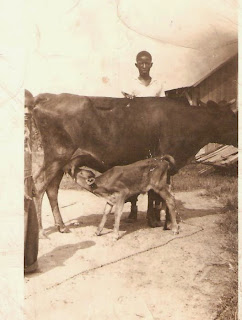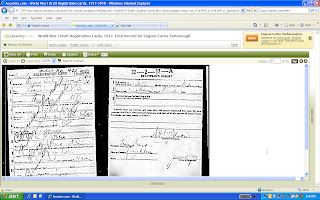The Library of Virginia is indeed a beautiful building. It is spacious, well-lit, and beautifully appointed. I'd gone there planning to tour the entire edifice, and take it all in, with plans only to view and get copies of three of my Norfolk, VA ancestors. After all, I was only in Richmond for an impromtu breakfast meet-up with my youngest daughter. This was just going to be a quick stop on a day filled with "to-do"s. Four hours after arriving, I was reluctantly leaving for the drive back home to attend an afternoon engagement. Not only did I have the death certificates (which provided lots of surprising information that I'll blog about later), but I'd also taken advantage of the Pro-Quest access to uncover more articles about my ancestors, the tiniest of which provided me with information about the family of my elusive grandfather, Daniel W. Hill, my mother's father (who abandoned their family when she was just four).
Daniel Webster Hill has, until now, just basically been a name on my family tree. He is definitely one of my brick walls, and he is the one closest to me, generationally, as he was my mother's father. Daniel and my grandmother, Mary Davis Walker, were married in Philadelphia in 1929, and they lived there for a short time after they wed. However, by 1930, they are already back in Norfolk, VA, living in the home which Mary had moved out of to join Daniel in PA. I've often wondered why they returned to Norfolk so soon, but perhaps now, I've found my answer.
As a result of my search of the Norfolk Journal and Guide on ProQuest for "Daniel Hill Norfolk", this little article popped up.
It reads: Mrs. Pinkie Howell of Gilmerton, VA, who was strickin with illness while visiting her daughter in Philadelphia, Pa., died Sunday, May 19. The remains were brought to Gilmerton for funeral and internment. She leaves to mourn her loss a son, Mr. Daniel Hill, of Norfolk, and one daughter, Mrs. Emma Hayes of Philadelphia.
..... and
the
brick wall
began to immediately
tumble
down.....
In just these three little lines, I learned the following information that I never knew before:
- The name of my great-grandmother. Pinkie Howell would have been my mother's grandmother. This explains so much for me, as I've often wondered how and why she never knew her father's parents, or any of his relatives, despite the fact that he abandoned the family when she was four. I've asked her and her brother many times if they are sure that no one ever asked after them, or visited them from their father's family. They've always insisted that no one had, and they've both grown old not knowing a thing about their own father or his family - except for their father's name. Now, at least I can let them know that it wasn't that their own grandmother didn't care enough to want to know them; she had passed before either of them were ever born. :(
- The origin of my mother's brother's first name, Howell. My grandparents named their first-born child, Howell Webster Hill. I've always felt that the "Howell" had to be for something or someone, since they gave him the same middle name as his father (Webster). Now that I've discovered his mother's surname, I'm beginning to question whether or not Daniel's real last name might've been Howell, too. Maybe he was running or hiding from something or someone, and maybe this is why he's remained a brick wall for so many years. This is a stretch though, because there are some other Hills in the Norfolk area who my mom and her brother say that we are related to. Maybe Pinkie was just married to a Howell who raised Daniel. I'll have to research this further.
- The location of my grandfather's family. According to the article, Pinkie Howell lived in Gilmerton, Va. Well, there is no longer a township by that name, but when I looked it up, I discovered that Gilmerton was actually located in Chesapeake, Va (which is right next to Norfolk), and after a few moments reflection, realized that it must be in the section of Chesapeake which now hosts the Gilmerton Bridge, which I hear about every morning and evening during the traffic segment on the news. This was confirmed today during a telephone conversation with my Uncle Howell, who lives in Chesapeake now. This means that my grandfather, Daniel Hill, whom I've always known was born in Virginia, was most likely raised right in Chesapeake.
- The fact that my grandfather had a sister, Emma, her married name, Hayes, and her location. This means that my mother and her brother had an aunt, who sadly, never knew them or vice-versa. However, Emma will most likely be the key to my finding out more about my grandfather's family and circumstances, and she may even lead me discovering what happened to him. I've already found the Emma Hayes that I'm pretty certain is her.If I'm right, she was married to McCabe Hayes, a gentleman who appears to have been 8 years younger than she, and who was a WWI Veteran.
From this 1920 Census document, I also learn that Emma's father was born in North Carolina, and her mother in Virginia. Assuming that Emma and Daniel shared the same parents, these would be my great-great grandparents. :)
- In addition to the information above, several "mysteries" have been cleared up for me by this article. I now understand why, despite an announcement in the Journal and Guide (which I shared in a previous post) that my grandparents (Daniel and Mary) were married and had moved to Philadelphia in 1926, they were back living at her home in Norfolk by the time the 1930 Census was taken. I also never understood just how it came to be that they got married in Philadelphia, rather than in Virginia. Even though my mother and her brother have always said that their father had some kind of connection to Philadelphia, they never seemed to know what it was. Now, we know that at least one close relative, Daniel's sister, Emma was there. Perhaps, after the death of their mother, they came back this way to close her affairs. I may never know the answer to that, but at least it all makes more sense now.
Thanks for reading. :)
Renate








